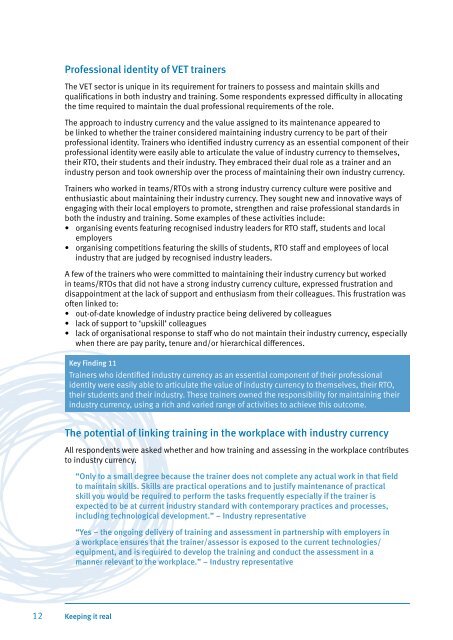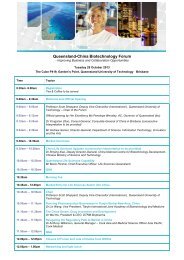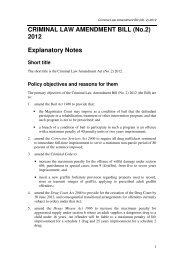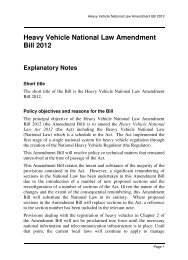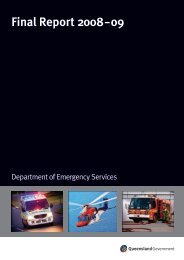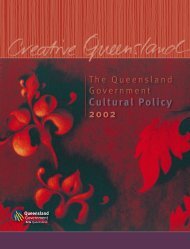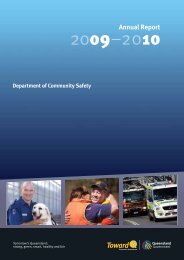Keeping it real - the Queensland VET Development Centre
Keeping it real - the Queensland VET Development Centre
Keeping it real - the Queensland VET Development Centre
- No tags were found...
Create successful ePaper yourself
Turn your PDF publications into a flip-book with our unique Google optimized e-Paper software.
Professional ident<strong>it</strong>y of <strong>VET</strong> trainersThe <strong>VET</strong> sector is unique in <strong>it</strong>s requirement for trainers to possess and maintain skills andqualifications in both industry and training. Some respondents expressed difficulty in allocating<strong>the</strong> time required to maintain <strong>the</strong> dual professional requirements of <strong>the</strong> role.The approach to industry currency and <strong>the</strong> value assigned to <strong>it</strong>s maintenance appeared tobe linked to whe<strong>the</strong>r <strong>the</strong> trainer considered maintaining industry currency to be part of <strong>the</strong>irprofessional ident<strong>it</strong>y. Trainers who identified industry currency as an essential component of <strong>the</strong>irprofessional ident<strong>it</strong>y were easily able to articulate <strong>the</strong> value of industry currency to <strong>the</strong>mselves,<strong>the</strong>ir RTO, <strong>the</strong>ir students and <strong>the</strong>ir industry. They embraced <strong>the</strong>ir dual role as a trainer and anindustry person and took ownership over <strong>the</strong> process of maintaining <strong>the</strong>ir own industry currency.Trainers who worked in teams/RTOs w<strong>it</strong>h a strong industry currency culture were pos<strong>it</strong>ive andenthusiastic about maintaining <strong>the</strong>ir industry currency. They sought new and innovative ways ofengaging w<strong>it</strong>h <strong>the</strong>ir local employers to promote, streng<strong>the</strong>n and raise professional standards inboth <strong>the</strong> industry and training. Some examples of <strong>the</strong>se activ<strong>it</strong>ies include:• organising events featuring recognised industry leaders for RTO staff, students and localemployers• organising compet<strong>it</strong>ions featuring <strong>the</strong> skills of students, RTO staff and employees of localindustry that are judged by recognised industry leaders.A few of <strong>the</strong> trainers who were comm<strong>it</strong>ted to maintaining <strong>the</strong>ir industry currency but workedin teams/RTOs that did not have a strong industry currency culture, expressed frustration anddisappointment at <strong>the</strong> lack of support and enthusiasm from <strong>the</strong>ir colleagues. This frustration wasoften linked to:• out-of-date knowledge of industry practice being delivered by colleagues• lack of support to ‘upskill’ colleagues• lack of organisational response to staff who do not maintain <strong>the</strong>ir industry currency, especiallywhen <strong>the</strong>re are pay par<strong>it</strong>y, tenure and/or hierarchical differences.Key Finding 11Trainers who identified industry currency as an essential component of <strong>the</strong>ir professionalident<strong>it</strong>y were easily able to articulate <strong>the</strong> value of industry currency to <strong>the</strong>mselves, <strong>the</strong>ir RTO,<strong>the</strong>ir students and <strong>the</strong>ir industry. These trainers owned <strong>the</strong> responsibil<strong>it</strong>y for maintaining <strong>the</strong>irindustry currency, using a rich and varied range of activ<strong>it</strong>ies to achieve this outcome.The potential of linking training in <strong>the</strong> workplace w<strong>it</strong>h industry currencyAll respondents were asked whe<strong>the</strong>r and how training and assessing in <strong>the</strong> workplace contributesto industry currency.“Only to a small degree because <strong>the</strong> trainer does not complete any actual work in that fieldto maintain skills. Skills are practical operations and to justify maintenance of practicalskill you would be required to perform <strong>the</strong> tasks frequently especially if <strong>the</strong> trainer isexpected to be at current industry standard w<strong>it</strong>h contemporary practices and processes,including technological development.” – Industry representative“Yes – <strong>the</strong> ongoing delivery of training and assessment in partnership w<strong>it</strong>h employers ina workplace ensures that <strong>the</strong> trainer/assessor is exposed to <strong>the</strong> current technologies/equipment, and is required to develop <strong>the</strong> training and conduct <strong>the</strong> assessment in amanner relevant to <strong>the</strong> workplace.” – Industry representative12 <strong>Keeping</strong> <strong>it</strong> <strong>real</strong>


